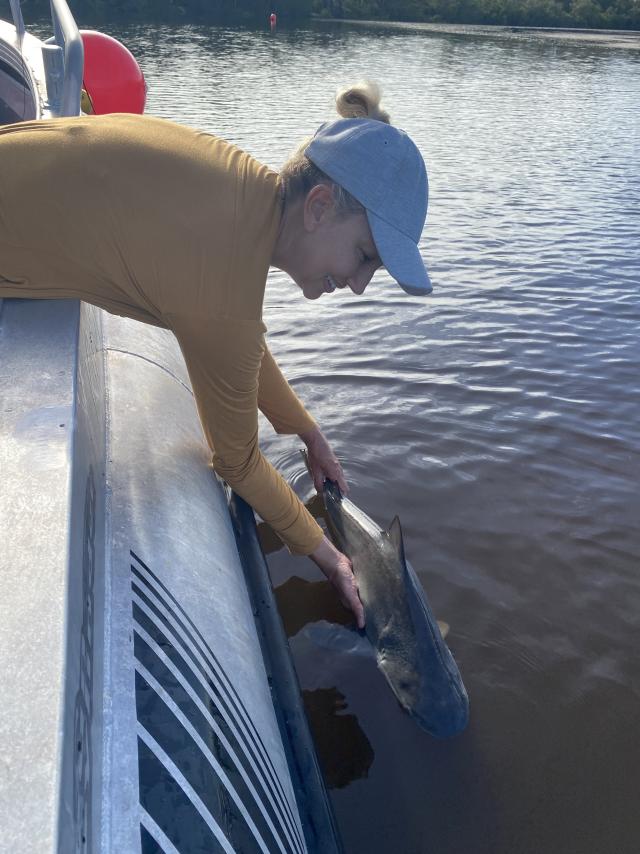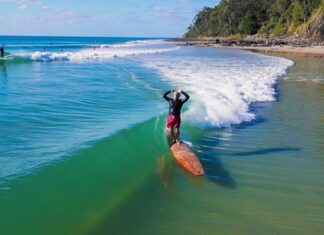New research has found bull sharks exist in healthy populations in the Noosa River, is showing the ways they inhabit the ecosystem and may lead to helping humans avoid shark attacks.
Bull sharks prefer murky water and occupy different areas of their river habitat depending on their age, the seasons and the time of day.
Large female bull sharks return to the same river where they were “pupped” to pup their own young, every two years between November and March, with the juveniles spending 5-6 years in the fresh water, moving from the safer upper reaches of the river before progressing to the river mouth, Laguna Bay and the open ocean.
This is just some of the behavioural information University of Sunshine Coast marine ecology senior lecturer Dr Bonnie Holmes has discovered in her research on Sunshine Coast bull sharks.
In front of a record crowd at Noosa Parks Association’s Friday Forum last week Bonnie said before her team began studying bull sharks in the region two and a half years ago not a single published study had been done on the marine animals despite there being general knowledge of quite large populations on the Sunshine Coast.
The team has since inserted internal transmitters and tagged more than 100 bull sharks from neonates to 3m females from which they are able to track their movements via a series of acoustic receivers located in the Noosa, Maroochydore and Mooloolah Rivers and the Pumicestone Passage as well from shared information from other researchers receivers located along coastal waters.
Bonnie said the team were investigating the sharks movements by sex, size and region as well as looking at the drivers of their movement. Using biological samples taken during tagging they are researching genetics and biological health.
She said their information could give an indication of when the sharks were active and they hoped their research could facilitate forming risk-based management strategies for human-shark interaction.
“The state government will not make changes (to its shark management program) without good scientific evidence backing that up and we don’t have that yet,” she said.
“We’re starting to get information to understand how bull sharks are using the ecosystem.”
She said by taking the detected information and plotting it on a river map, they can see the neonates remain in the safer, shallow waters of Lake Cootharaba, juveniles move down to Lake Cooroibah, while the sub adults start to push out into Laguna Bay and explore what’s in the bay where they face their first exposure to other large sharks and predators.
But bull sharks all have individual personalities, she said. They don’t all do same thing, just like your pet dog.
The Queensland Shark Control Program consists of a combination of nets and drum lines at 85 beaches along the Queensland coast including Noosa beaches.
Bonnie said their research to date shows the bull shark catch in Laguna bay is dominated by sub adults and the bull shark catch rates drop significantly in winter, a time they suspect the larger ones move offshore into warmer waters.
Their tracking shows some bull sharks manage to avoid all nets and drum lines along the Sunshine Coast region, whether that is a learned behaviour or just luck, and others are not so lucky and are caught.
Bonnie said a lot of non target species were captured and killed in the shark control program as are target species. From Bundaberg to the Gold Coast the Queensland shark control program is 100 per cent lethal for target species which even if captured alive are euthanised, she said.
In 2017, the Humane Society International challenged the issuance of a 10-year permit by the Great Barrier Reef Marine Park Authority (GBRMPA) to the Queensland Department of Agriculture and Fisheries (QDAF) to operate a lethal Shark Control Program.
On 2 April 2019, the Administrative Appeals Tribunal (AAT) found ‘overwhelming’ evidence that shark culling did not reduce the risk of shark bite but did pose a risk to the health of the Reef. They reported that the lethal component of the QSCP was “superficially attractive albeit unscientific,” and “out of step with national and international developments.”
Bonnie, who has been studying sharks for the past 20 years and completed a PhD on Tiger sharks, and her team have secured funding for more research over the next three years.
Future projects include installing more receivers in Laguna Bay to track the movement of bull sharks in the bay and more biological sampling to determine evidence of parasites or heavy metals which could see sharks becoming bio-indicators of river health.
Bonnie said their results were just scratching the surface with other studies needed to fill the many gaps in our knowledge of bull sharks.







